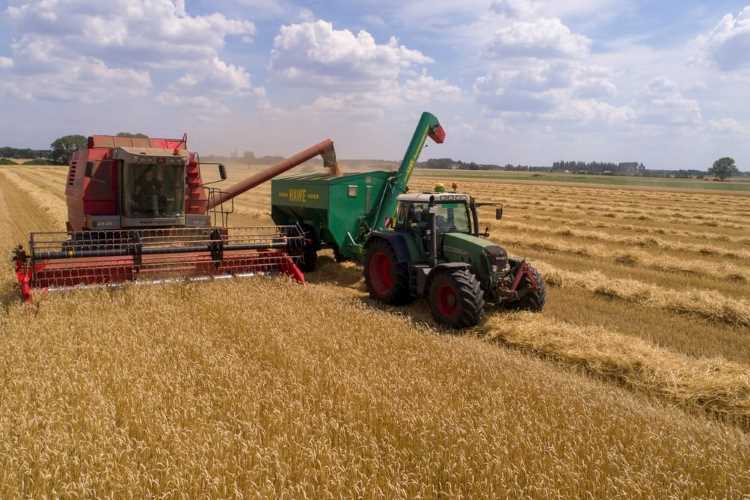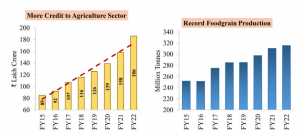
The agriculture sector in India is a crucial part of the country’s economy as it employs about 50% of the country’s workforce and contributes about 15% to India’s GDP. The Union Budget 2023 has 10 key proposals to turbocharge the sector.
India’s agriculture sector is dominated by small and marginal farmers who face challenges such as low productivity, limited access to credit, and lack of modern technology. The government programmes look to support the sector through increased investment in irrigation, distribution of high-yielding crop varieties, and promotion of agro-processing industries.
READ I Rural sector: Budget 2023 shows intention, but falls short on allocation

Budget 2023 pushes Green Farming
The government will help 1 crore farmers to adopt natural farming in the coming three years. The plan is to help Indian farmers adopt traditional and indigenous practices for encouraging all forms of ecological farming. It will provide chemical fertiliser-free and pesticide-free food grains and other crops, improve soil health and reduce environmental pollution. It focusses on capacity building, training, handholding, and on-field demonstration of natural farming through champion farmers.
PM Pranam
The Promotion of Alternate Nutrients for Agriculture Management scheme seeks to promote soil health and agriculture productivity. PM Pranam incentivises states and UTs to promote balanced use of chemical fertilisers and use of alternative fertilisers. This would push agriculture towards alternative fertilisers and more judicious use of chemicals. The basic objective of the scheme is to incentivise the farmers to reduce the overall consumption of fertilisers through creation of a proper environment.
Global hub for millets
Promotion of millets follows the declaration of 2023 as the International Year of Millets by the Food and Agriculture Organisation of the United Nations. Millets, cultivated mostly on un-irrigated lands by small and marginal farmers, are climate resilient food with high nutritional value. India is the largest producer and the second largest exporter of Millets in the world. The programme looks to augment demand, boost exports, reduce water consumption in agriculture and augment farmers’ incomes. The Indian Institute of Millets Research in Hyderabad is being developed as a centre of excellence.
Development of horticulture
As income levels rise, consumers move from cereals to fruit and vegetables. Given that 12% of the cultivated area accounts for 24% of the farm GDP in value terms, it is a source of buoyant income for farmers. Aatmanirbhar Clean Plant Programme looks to boost the availability of disease-free, quality planting material. Further leveraging the geographical specialisation of horticulture clusters and promoting integrated and market-led development of pre-production, the production and post-harvest activities will augment farmers’ income levels.
PM Matsya Sampada Yojana
A new sub-scheme will be launched with a targeted investment of Rs 6,000 crore to further enable activities of fishermen, fish vendors, and micro and small enterprises, improve value chain efficiencies, and expand the market.
Waste to Wealth
Rs 10,000 crore has been allocated for the GOBARdhan scheme to develop 500 new compressed biogas plants to help villages manage cattle waste, agriculture waste and organic waste to biomass and fertilisers. It will also help villages convert their waste to wealth, improve environmental sanitation and curb vector borne diseases through effective disposal of waste in rural areas. The support for the collection and distribution of biomass would encourage a circular economy in the agricultural waste and transport sectors.
Sahakar-Se-Samriddhi
A renewed impetus is given to the growth of the cooperative sector to promote primary agriculture credit societies (PACS). The proposed computerisation of 63,000 cooperative societies will unlock the true potential and strengthen the cooperative movement in the country, deepen its reach to the grassroots, and promote cooperative-based economic development.
Agriculture Accelerator Fund
This is being set up to encourage and support agro startups in rural areas. It will implement cost-effective solutions to problems encountered by farmers by introducing contemporary technologies such as AI and drones for monitoring soil and crop health. Smart farming Practices will assist farmers in improving farming techniques and will help develop farmer-centric solution for crop planning.
Agriculture credit
With a focus on animal husbandry, dairy and fisheries sectors, an 11% increase in agriculture credit to Rs 20 lakh crore has been provided for 2023-24. This will enable farmers to meet their short-term crop loan requirements.
Decentralised Storage Capacity
Budget 2023 has proposed to create efficient storage capacity for agri-commodities with improved infrastructure like cold storages and better logistics. This will help reduce wastage, prevent distress sale of the produce, improve value addition, ensure better farmers’ returns, promote employment, and increase export earnings.
The government looks to reorient the agriculture sector to higher levels of farmers welfare through green farming, promoting digital technology and AI driven solutions, setting up of agro start-ups in rural areas, decentralised storage and thus better price realisation. All this will help the country achieve $100 billion agri-exports by 2030 compared with just $50.2 billion in 2020-21. Digitisation and the resultant efficiency gains coupled with upskilling of farm workers will be an important driver of India’s economic growth in the medium term.
The sector still faces challenges such as poor infrastructure, limited access to markets, and unfavourable weather conditions, but it continues to be an important source of food security and economic growth for India.

